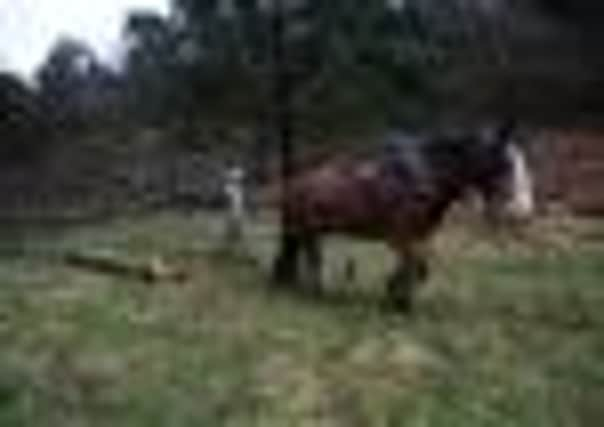Video: Glade tidings as woodland work is done on the hoof


Mighty Shires and Clydesdales can cope with muddy conditions and steep banks as well as anything made by man.
For conservationists working for the National Trust in Yorkshire, the appeal is that these four-legged workhorses do not leave behind tyre tracks or diesel fumes.
Advertisement
Hide AdAdvertisement
Hide AdAt Hardcastle Crags, a beauty spot at Hebden Bridge, a heavy horse and its master are helping preserve a finely-balanced environment which includes species such as the Northern Hairy Wood ant, eight species of bat, wild deer and three kinds of woodpecker.


Horse logger Peter Coates, 58, and his trusty Shire-Clydesdale cross Nathan are helping to clear heavy timber at the estate to create improved habitats for a variety of plant and animal species.
Staff, volunteers and businesses began the works two weeks ago to help restore wildlife habitats, improve the landscape and ensure the area is safe for visitors.
The Trust’s plan involves selective felling of non-native trees and the thinning of larch and pine plantations.
Advertisement
Hide AdAdvertisement
Hide AdThis work will help species like the northern hairy wood ant by creating open glades that will enable the ants to build new nests.
It will also provide open areas for bats to forage for food while encouraging woodland birds by creating better nesting habitats.
Local rangers Drew Marsh and Ed Brightman, along with National Trust volunteers are working alongside woodland co-operative Blackbark and local company Outdoor Classrooms to fell trees identified in the plan.
Areas of woodland are being reduced in density as non-native trees are felled and moved to suitable places by Nathan, under the guidance of Mr Coates.
Advertisement
Hide AdAdvertisement
Hide AdNabil Abbas, countryside manager of Hardcastle Crags, said: “Peter and Nathan first came to help us moving logs at the end of last winter so it’s a pleasure to have them both back again.
“By literally harnessing horse power, we are able to extract logs from steep areas where heavy machinery cannot go, and Nathan doesn’t leave any damaging tyre tracks.
“They will be helping us with our woodland work throughout the winter.”
Many of the trees at the Crags were planted at least 130 years ago, which means that they are reaching the end of their natural life span and if left would pose a threat to people visiting the site.
Advertisement
Hide AdAdvertisement
Hide AdMr Abbas added: “The work we’re doing will help restore the natural balance of the woodland as well as improving the overall appearance of the property, allowing visitors to walk safely around the site and enjoy the views of the Crags.
“We couldn’t move all of the trees and logs without Peter and Nathan so we’re very grateful for their help.”
In the woodland areas being “thinned out” around one in four trees were being removed which was “in the long-term best interests of the woodland”, he added.
In some cases, large trees are being removed as a precaution against them falling onto nearby buildings in a storm – and to improve views for the 150,000 annual visitors.
Advertisement
Hide AdAdvertisement
Hide AdThe aim is to improve plant and wildlife diversity and thin out the dense plantation “blocks”.
“We are also clearing some of the edges of the riverbanks and mill ponds so they get more light, which benefits aquatic life.”
Mr Coates, who has been working with heavy horses for a decade, said Nathan was the ideal choice for such delicate work.
“We can take horses where they cannot get a tractor and they do little damage. They can pull single logs weighing up to one tonne.
Advertisement
Hide AdAdvertisement
Hide Ad“We use a two-wheel bogey like a chariot. Nathan can shift up to 50 logs in a day. It is hard work for him and he does sometimes slide down if he is going down hill.
“He sometimes pulls a face but I have a pocketful of carrots and feed nuts to keep him happy as he needs to eat all day long, being a vegetarian. He knows he’s done a day’s work when he’s finished.”